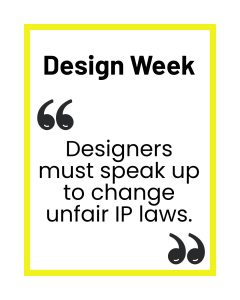

In a world where the internet is a catalyst for communication, what images can, and can’t you use? What happens when you commission a photographer to photograph your new designs; who owns the copyright? Images, artwork and photos are some examples of copyright works and, generally, ownership can cause confusion.
Copyright, quite simply, is a property right that grants the creator of an original work exclusive rights to decide, and under what conditions, original work may be used by others.
Usually those who create copyright works use the symbol © in front of their name and the date to assert their copyright. However, just because there is no © symbol it doesn’t mean the copyright is not protected.
Take a look at some of ACID’s frequently asked questions about using photography and images
Q As a designer of a new fashion and giftware range, I have recently commissioned a freelance photographer to take images of my new designs for promotion for my new brochure and also our website. As the commissioner of the photography, do I own the copyright in the designs?
No, even though you have paid the photographer, the photographer will be the first owner of the copyright in the photographs of your designs and you will have to obtain their permission. However, a photographer can include licence terms which explain all the rules by which you must observe – printing further copies, sharing or posting on the internet. Equally, as the commissioner you may wish to ask the photographer and he/she may agree to assign the IP rights and for this you will need a Copyright Assignment Agreement. One way or another clarity of ownership is critical.
Moral rights – the photographer will also have moral rights associated with the photographs they have taken. This means that you will have to take into consideration not using the images in a manner that could be interpreted as derogatory by the photographer.
Q do I need permission to take photos of buildings located in public spaces?
No, you do not need permission as you will own the copyright in any photos that are taken, and you can use them commercially. Care should be taken when photographing posters, pavement artist’s work or advertisements, for example as this could be an infringement of their copyright.
Q If I see image on the internet and I want to use them for my business what are the basic rules?
The majority of images on the in the internet are most likely to be protected by copyright. So, ascertain first whether the copyright term has expired (usually 70 years plus the life of the creator) and if it has you are free to use them. Otherwise, obtain permission through a licence or a Creative Commons Licence. Also, don’t forget that if you can’t find the owner to ask, these copyright works are called “orphan works” and you can find out more information on this on the intellectual property website.
Q I am sick of other’s using my photos on social media. Can I do anything?
It may be laborious, but it is always good to check the website terms and conditions about the use of your images. We live in a world where many of us “tick” terms and conditions as read and understood. At the end of the day it is the small print you must rely on to assert your rights. For example, if you ticked to a condition that allowed such use you may have a weaker case when you ask the website operator to remove the photographs. You can think about exposing this infringement of your copyright but a word of extreme caution. You could breach defamation laws. Always seek the advice of a legal advisor as to how best to approach this.
Q I have seen an image that I want to use on the internet and want to create a new artwork
There are many myths and howlers out there and you may have taken just a tiny element of an image and then recreated your own work. Beware, the legal test is the interpretation of the term “substantial part” so even using just a relatively small part of a work could be regarded as infringement. Basically, using any part of a copyright work without permission will usually infringe the rights of the creator. Many often say “I have changed a certain percentage or made a number of changes, so it is a new creation”. This is a frequently discussed WRONG assumption about designs and copyright.
One recent enquirer wanted to know if they took 3 original images and “scrambled them up (so you couldn’t even work out what the original image was)” would this be allowed. ACID’s answer was that, in view of the above application of the law, it is a) not worth the risk and b) does not basically demonstrate that this person respected copyright laws if they were prepared to find a way around them!
Q If I want to use my own image on the internet that I have created myself, are there any watchpoints?
Generally, you will own the copyright, so you are free to use them as you wish. However, you should be aware that if you created them in employment you would need to ask your employer’s permission. Or, for example, if you take a photo of, say, an artwork in a gallery image or an ad on the tube or for a film, this could be an infringement of copyright.
Q What happens if I infringe a copyright work?
Many creators are becoming “IP savvy” and, as a result, we are seeing an increasing number of successful settlements which is good news for IP owners. However, for those who use copyright or design without permission and legal action is taken against you, you may have to go to Court and this is expensive. If the challenge is successful you may have to pay substantial costs. The worst case scenario is that deliberate infringement of a copyright on a commercial basis may also lead to a criminal prosecution. If successful, this could lead to a criminal record which has serious consequences, not least a prison sentence of up to 10 years.
Q What are your queries about using the copyright of others?
Let us know and we will use these as the basis for another article addressing your particular concerns. Email ACID at [email protected]. Intellectual property should be seen as a positive force, supporting your innovation and creation of new IP through creative talent. The law is there to protect, and it is also there to enforce so, knowing and understanding some of the basic rules is a great way to ensure you don’t infringe the rights of others.
ACID supports all IP creators with an IP Databank. Put simply, if you want to take legal action against someone who is using your copyright or unregistered design right without permission you need evidence. Lodging your work on the IP Databank doesn’t add to your existing rights (created automatically) but does give you a tamper proof certificate that your files and documents have been received by an independent third party i.e., ACID. Creating an audit trail behind your work to prove you own your IP, is essential. It is not rocket science! So often, assertion of a proactive IP strategy can be reinforced by a few simple words on your website such as “All intellectual property rights in our images, artworks and design belong to (insert your name) any infringement will be treat seriously.” Prevention and deterrence play a key role in communicating an anti-copying message.
Spread the Word

Latest News





Newsletter Sign-Up
| Cookie | Duration | Description |
|---|---|---|
| cookielawinfo-checkbox-analytics | 11 months | This cookie is set by GDPR Cookie Consent plugin. The cookie is used to store the user consent for the cookies in the category "Analytics". |
| cookielawinfo-checkbox-functional | 11 months | The cookie is set by GDPR cookie consent to record the user consent for the cookies in the category "Functional". |
| cookielawinfo-checkbox-necessary | 11 months | This cookie is set by GDPR Cookie Consent plugin. The cookies is used to store the user consent for the cookies in the category "Necessary". |
| cookielawinfo-checkbox-others | 11 months | This cookie is set by GDPR Cookie Consent plugin. The cookie is used to store the user consent for the cookies in the category "Other. |
| cookielawinfo-checkbox-performance | 11 months | This cookie is set by GDPR Cookie Consent plugin. The cookie is used to store the user consent for the cookies in the category "Performance". |
| viewed_cookie_policy | 11 months | The cookie is set by the GDPR Cookie Consent plugin and is used to store whether or not user has consented to the use of cookies. It does not store any personal data. |